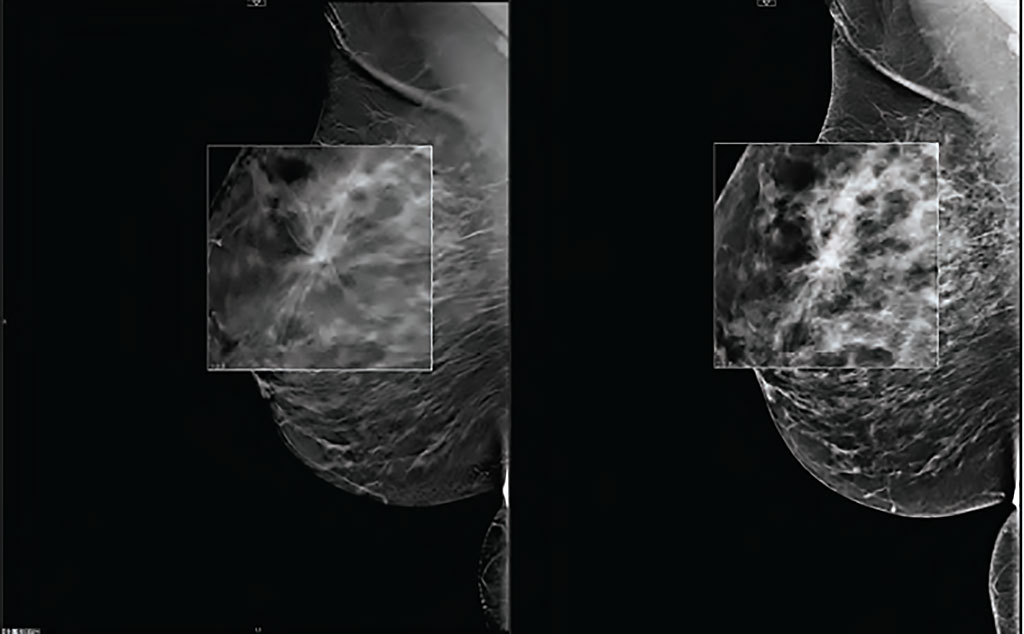DBT Increases Cancer Detection Rates and Reduces Recalls
|
By HospiMedica International staff writers Posted on 03 Mar 2020 |

Image: DBT can increase breast cancer detection rates (Photo courtesy of Carestream)
A new study finds that digital breast tomosynthesis (DBT) finds more than twice as many breast cancers as digital mammography alone, or a combination of the two technologies.
Researchers at Harvard Medical School (HMS; Boston, MA, USA) and Brigham and Women's Hospital (BWH; Boston, AM, USA) conducted a study that compared the diagnostic performance of breast cancer screening via full-field digital mammography (FFDM), a hybrid FFDM and DBT environment, and DBT only. A total of 179,028 screening mammograms were conducted, comprised of 41,818 (23.3%) FFDM, 83,125 (46.4%) hybrid scans, and 54,084 (30.2%) scans by DBT alone.
The researchers then used the electronic health record (EHR) data to extract report records and patient demographics, a natural language processing algorithm to extract BI-RADS score from each report, and an institutional cancer registry to identify cancer diagnoses. The results showed that cancer detection rates were 2.6 per 1,000 examinations for FFDM, 4.9 per 1,000 for hybrid scanning, and 6.0 per 1,000 for DBT alone. Recall rates were 10.4% for the FFDM, 10.6% for the hybrid scans, and 10.8% for the DBT alone scans. The study was published on February 14, 2020, in the Journal of the American College of Radiology.
“Compared with FFDM, DBT improves breast cancer detection in screening mammography, which more than doubled,” concluded lead author Laila Cochon, MD, of Brigham and Women's Hospital and HMS, and colleagues. “Although overall recall rate did not change with DBT when compared with FFDM, even over time, an improvement in the positive predictive value for number of cancers per number of recalls reflects a reduction in unnecessary recalls."
DBT acquires multiple images over a limited angular range to produce a set of reconstructed images, which can then be viewed individually or sequentially in a cine loop, and in a 3D image of the breast, which can viewed in narrow slices, similar to CT scans. While in conventional 2D mammography overlapping tissues can mask suspicious areas, 3D images eliminate the overlap, making abnormalities easier to recognize. It is estimated that 3D DBT will replace conventional mammography within ten years.
Related Links:
Harvard Medical School
Brigham and Women's Hospital
Researchers at Harvard Medical School (HMS; Boston, MA, USA) and Brigham and Women's Hospital (BWH; Boston, AM, USA) conducted a study that compared the diagnostic performance of breast cancer screening via full-field digital mammography (FFDM), a hybrid FFDM and DBT environment, and DBT only. A total of 179,028 screening mammograms were conducted, comprised of 41,818 (23.3%) FFDM, 83,125 (46.4%) hybrid scans, and 54,084 (30.2%) scans by DBT alone.
The researchers then used the electronic health record (EHR) data to extract report records and patient demographics, a natural language processing algorithm to extract BI-RADS score from each report, and an institutional cancer registry to identify cancer diagnoses. The results showed that cancer detection rates were 2.6 per 1,000 examinations for FFDM, 4.9 per 1,000 for hybrid scanning, and 6.0 per 1,000 for DBT alone. Recall rates were 10.4% for the FFDM, 10.6% for the hybrid scans, and 10.8% for the DBT alone scans. The study was published on February 14, 2020, in the Journal of the American College of Radiology.
“Compared with FFDM, DBT improves breast cancer detection in screening mammography, which more than doubled,” concluded lead author Laila Cochon, MD, of Brigham and Women's Hospital and HMS, and colleagues. “Although overall recall rate did not change with DBT when compared with FFDM, even over time, an improvement in the positive predictive value for number of cancers per number of recalls reflects a reduction in unnecessary recalls."
DBT acquires multiple images over a limited angular range to produce a set of reconstructed images, which can then be viewed individually or sequentially in a cine loop, and in a 3D image of the breast, which can viewed in narrow slices, similar to CT scans. While in conventional 2D mammography overlapping tissues can mask suspicious areas, 3D images eliminate the overlap, making abnormalities easier to recognize. It is estimated that 3D DBT will replace conventional mammography within ten years.
Related Links:
Harvard Medical School
Brigham and Women's Hospital
Latest General/Advanced Imaging News
Channels
Critical Care
view channel
AI Heart Attack Risk Assessment Tool Outperforms Existing Methods
For decades, doctors have relied on standardized scoring systems to assess patients with the most common type of heart attack—non-ST-elevation acute coronary syndrome (NSTE-ACS). The GRACE score, used... Read more
'Universal' Kidney to Match Any Blood Type
Blood-type incompatibility has long been one of the greatest obstacles in organ transplantation, forcing thousands of patients—particularly those with type O blood—to wait years longer for compatible donors.... Read moreSurgical Techniques
view channel
Minimally Invasive Endoscopic Surgery Improves Severe Stroke Outcomes
Intracerebral hemorrhage, a type of stroke caused by bleeding deep within the brain, remains one of the most challenging neurological emergencies to treat. Accounting for about 15% of all strokes, it carries... Read more
Novel Glue Prevents Complications After Breast Cancer Surgery
Seroma and prolonged lymphorrhea are among the most common complications following axillary lymphadenectomy in breast cancer patients. These postoperative issues can delay recovery and postpone the start... Read morePatient Care
view channel
Revolutionary Automatic IV-Line Flushing Device to Enhance Infusion Care
More than 80% of in-hospital patients receive intravenous (IV) therapy. Every dose of IV medicine delivered in a small volume (<250 mL) infusion bag should be followed by subsequent flushing to ensure... Read more
VR Training Tool Combats Contamination of Portable Medical Equipment
Healthcare-associated infections (HAIs) impact one in every 31 patients, cause nearly 100,000 deaths each year, and cost USD 28.4 billion in direct medical expenses. Notably, up to 75% of these infections... Read more
Portable Biosensor Platform to Reduce Hospital-Acquired Infections
Approximately 4 million patients in the European Union acquire healthcare-associated infections (HAIs) or nosocomial infections each year, with around 37,000 deaths directly resulting from these infections,... Read moreFirst-Of-Its-Kind Portable Germicidal Light Technology Disinfects High-Touch Clinical Surfaces in Seconds
Reducing healthcare-acquired infections (HAIs) remains a pressing issue within global healthcare systems. In the United States alone, 1.7 million patients contract HAIs annually, leading to approximately... Read moreHealth IT
view channel
Printable Molecule-Selective Nanoparticles Enable Mass Production of Wearable Biosensors
The future of medicine is likely to focus on the personalization of healthcare—understanding exactly what an individual requires and delivering the appropriate combination of nutrients, metabolites, and... Read moreBusiness
view channel
Philips and Masimo Partner to Advance Patient Monitoring Measurement Technologies
Royal Philips (Amsterdam, Netherlands) and Masimo (Irvine, California, USA) have renewed their multi-year strategic collaboration, combining Philips’ expertise in patient monitoring with Masimo’s noninvasive... Read more
B. Braun Acquires Digital Microsurgery Company True Digital Surgery
The high-end microsurgery market in neurosurgery, spine, and ENT is undergoing a significant transformation. Traditional analog microscopes are giving way to digital exoscopes, which provide improved visualization,... Read more
CMEF 2025 to Promote Holistic and High-Quality Development of Medical and Health Industry
The 92nd China International Medical Equipment Fair (CMEF 2025) Autumn Exhibition is scheduled to be held from September 26 to 29 at the China Import and Export Fair Complex (Canton Fair Complex) in Guangzhou.... Read more
















